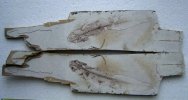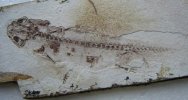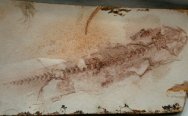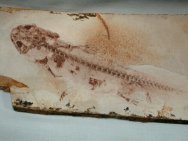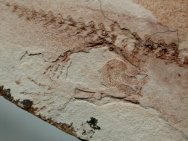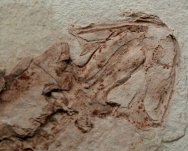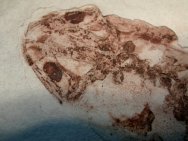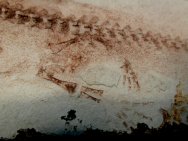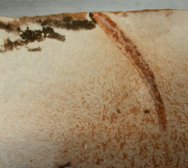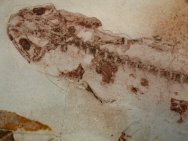Liaoxitriton
zhongjiani
Class
Amphibia, Superorder Batrachia, Order CaudataUrodela
Geologic
Time: Lower
Cretaceous, (~125 m.y.a.)
Size:
110 mm long (tip of skull to tip of tail along backbone). Matrix:
296 mm by 60 mm
Fossil
Site:
Huludao City, Jiufotang Formation, Liaoning Province of China
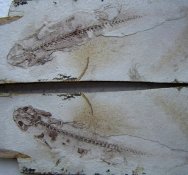 Description:
This is a fine positive/negative pair of a rarely seen amphibian;
a salamander known as Liaoxitriton zhongjiani. It is placed here
in the Reptile section of the store as amphibians are almost never
offered. The species takes its generic name from Liaoxi, the general
region from which the specimen comes, while the specific name is
for the researcher who first discovered this specimen. The detail
is incredible; even more remains to be uncovered (see some of the
bones of the forearm). Even a 20 mm partial tail of another unknown
vertebrate is present. Phyletogentic analysis of the Urodeles shows
that Asia is the origin of the clade, leading to the hypothesis
that the basal salamanders radiated from the region. Some salamanders
demonstrate neoteny, or the capability of reproducing while in what
is apparently the larval state. Note the soft tissue outlines preserved,
and what appears to be gill structures, a telltale that this is
not a larval form but a neotenic example. Neoteny is not all that
uncommon among modern-day salamanders (some 40 species in 9 different
families demonstrate this strategy), with the Mexican Salamander
or Axolotl being a prime example. This means that it retains its
gills and fins, and it doesn't develop the protruding eyes, eyelids
and characteristics of other adult salamanders. It grows much larger
than a normal larval salamander, and it reaches sexual maturity
in this larval stage. The independent occurrence of neoteny in both
Mesozoic and recent groups of salamanders makes parallel evolution
of numerous morphological features an enduring feature of their
history. An example such as this of the first salamander to be discovered
from the Mesozoic in the east Asian region would make a fine addition
to any public or private collection. Description:
This is a fine positive/negative pair of a rarely seen amphibian;
a salamander known as Liaoxitriton zhongjiani. It is placed here
in the Reptile section of the store as amphibians are almost never
offered. The species takes its generic name from Liaoxi, the general
region from which the specimen comes, while the specific name is
for the researcher who first discovered this specimen. The detail
is incredible; even more remains to be uncovered (see some of the
bones of the forearm). Even a 20 mm partial tail of another unknown
vertebrate is present. Phyletogentic analysis of the Urodeles shows
that Asia is the origin of the clade, leading to the hypothesis
that the basal salamanders radiated from the region. Some salamanders
demonstrate neoteny, or the capability of reproducing while in what
is apparently the larval state. Note the soft tissue outlines preserved,
and what appears to be gill structures, a telltale that this is
not a larval form but a neotenic example. Neoteny is not all that
uncommon among modern-day salamanders (some 40 species in 9 different
families demonstrate this strategy), with the Mexican Salamander
or Axolotl being a prime example. This means that it retains its
gills and fins, and it doesn't develop the protruding eyes, eyelids
and characteristics of other adult salamanders. It grows much larger
than a normal larval salamander, and it reaches sexual maturity
in this larval stage. The independent occurrence of neoteny in both
Mesozoic and recent groups of salamanders makes parallel evolution
of numerous morphological features an enduring feature of their
history. An example such as this of the first salamander to be discovered
from the Mesozoic in the east Asian region would make a fine addition
to any public or private collection. |
|

